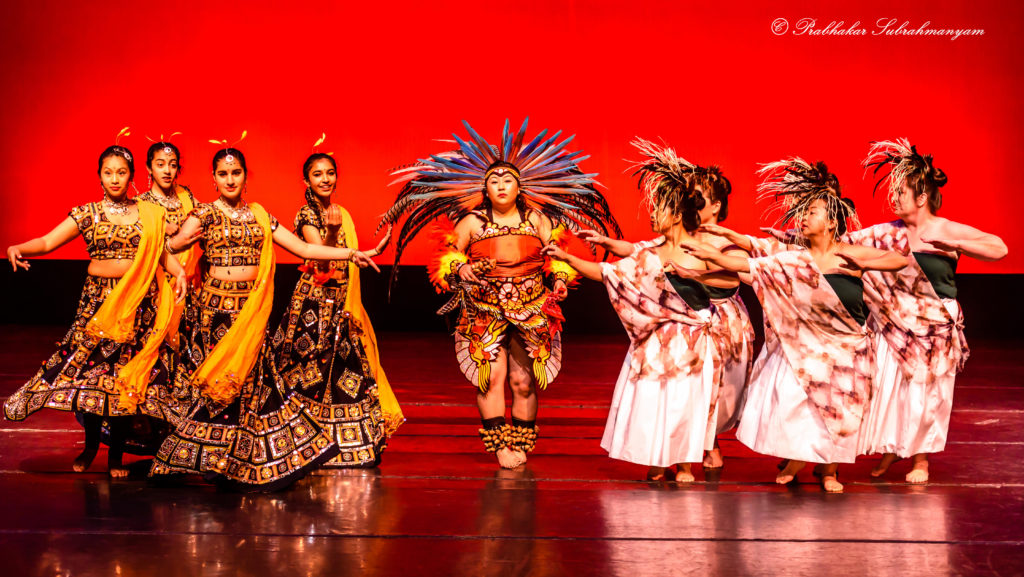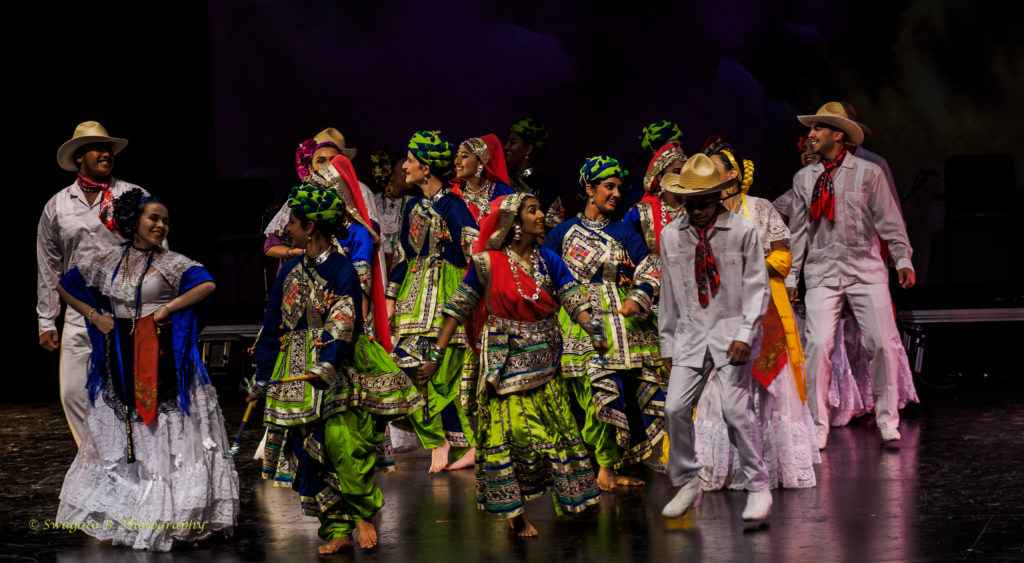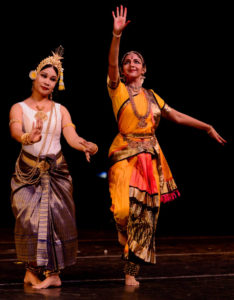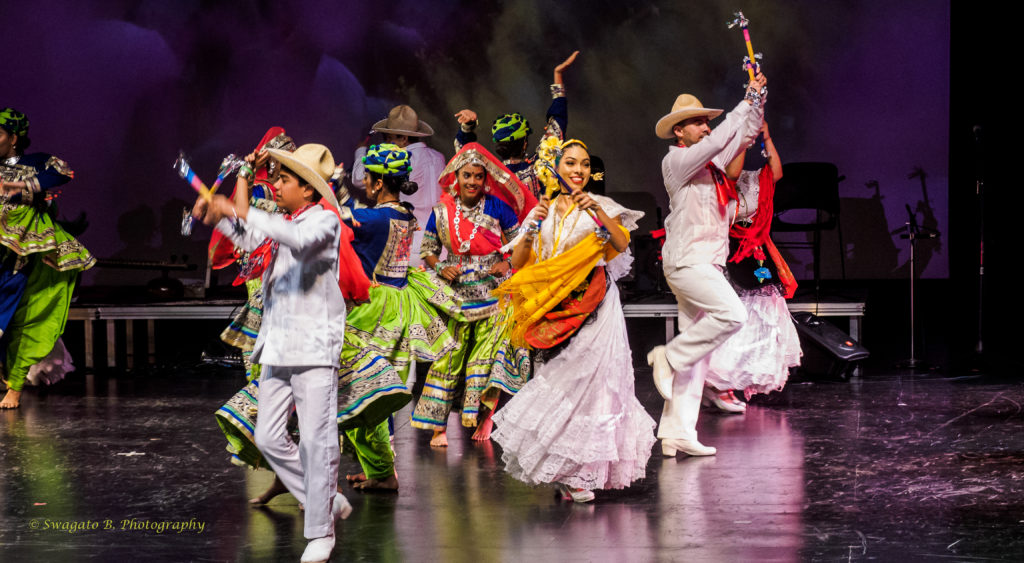
Mosaic America: A Movement for Moving Communities By Priya Das and Usha Srinivasan
Mosaic America: A Movement for Moving Communities
Typically seen as a form of individual expression, dance can be a form of worship, a powerful tool for passing on ritual and tradition through generations. Dance traditions, movements and songs that get passed down through generations are typically those that originate as expressions of everyday life. Nomadic tribes used dance and song to make a home wherever they were.
Dance in America began with the Indigenous peoples, as a spiritual offering to the celestials, and played a vital role in rituals and ceremonies. It also served as a medium of learning about nature and ancestors. The first waves of immigrants to the United States were from European nations, fleeing war and economic hardship. While their music and dance were distinct from each other, they originated in an era when a clear distinction existed between the dances and music of “common folk” and those of “high society” such as ballroom dance and symphonies. These were a sign of upward mobility, governed by strict etiquette and formality.
Due to their sponsorship by royalty and aristocracy, these dance forms reflected the ideas and propaganda of their sponsors. The porous nature of borders helped these art forms to proliferate and became prevalent throughout Europe before being imported into the United States. This inevitably led to some artistic “cultured,” mainstreamed homogeneity. Then as now, imitation was considered the sincerest form of flattery, and the hope of upward mobility went hand in hand with the discernment and appreciation for the arts. At some point in this evolutionary pattern, dance came to mean a skill, a talent, a study used to excel in movement; an art, rather than the practice of a culture or community.

The waves of immigration that followed World-War II, especially after the passage of the Civil Rights Act in 1965 attracted a more diverse group of immigrants, those who had their own dance forms that dated back millennia and differed greatly in their music, costume, and expression from those dance forms that came from Europe. But these non-European immigrants like us have found limited “mainstream” interest in their arts.
As first generation immigrants from India who learned Bharatanatyam as a hobby, we live among a diaspora rich with a multitude of classical music and dance traditions. Though all Indian classical dances take inspiration from the same text, their practitioners in Silicon Valley create and perform to limited audiences.
It was to address this fragmentation that Sangam Arts was founded in 2013. Our initial focus was on consolidating and expanding audiences for Classical Indian dance in Silicon Valley. Given the common threads that bind these forms including a rich repertoire rooted in Hindu spirituality and mythology, curating presentations featuring multiple Indian classical dance forms was straightforward. In 2014, Sangam Arts presented a ground-breaking showcase of all eight classical Indian dance forms at the San Francisco Ethnic Dance Festival.
OUR EVOLUTION FROM SANGAM TO MOSAIC
The Ethnic Dance Festival showcase experience brought two important realizations – 1) The richness and beauty of dance wasn’t unique to the Terpsichorean talents of the Indian diaspora. The Bay Area was home to many culturally distinct communities with vibrant dance forms being practiced at the highest levels – albeit within their cultural silos.
2) Festivals are a wonderful platform for acknowledgement and representation of cultures. However, creating collaborative works that tell meaningful stories for audiences with varying degrees of familiarity with the art forms and fostering a lasting connection between the communities they represent requires greater investment of time, money and purposeful curation.

This awareness led us to our foray into intercultural presentation Dances of Devotion featuring traditional Cambodian classical-dance master artist Charya Burt and renowned Indian-Bharatanatyam exponent Lavanya Ananth. Then came Conference of the Birds in 2016, in partner- ship with Enacte Arts, which brought together over 60 dancers and actors from 12 traditions ranging from Folklorico and Kathak to Hula and Aztec dance in a multicultural, multi- disciplinary rendition of the Sufi allegory scripted by the legendary Jean- Claude Carrière.
The lead-up to the 2016 elections laid bare the tatters in the social fabric of our nation. Hateful, racist rhetoric, aimed at exploiting xeno- phobia for political gain, highlighted the ugly reality that the all-American identity was bestowed on Whites by default while all others were hyphenated-Americans, forced to reckon with the question “Where are you really from?’’
We felt a sense of urgency to use the power of the arts to foster cultural cohesion.
So we wondered, what if we expanded the scope of Sangam’s work to include all cultures that have made their home in Silicon Valley and all the art forms on which each cul- ture thrived? Suddenly, the potential for wider appeal, for one-ness, and for meaningful interaction between cultures, seemed more attainable. We trusted in the power of the arts to stem the tide of divisiveness and began a new grassroots initiative under Sangam Arts called Mosaic.
A mosaic is a pattern made of stone, tile or glass produced by arranging together small pieces of material called tesserae. The absence of even a single tessera, either by error or omission leaves a mosaic unmanifested. We believe that in the gloriously diverse and culture-rich Bay Area, significant cohesion is possible through deliberately commissioned intercultural works of art: works that do not aim to erase nor exclude distinctions, but instead, allow them to softly grow and gain familiarity together, to fill an otherwise yawning gap, and forming a mosaic that is greater than the sum of its parts.
Mosaic programming uses the arts to help create a sense of belonging for all who live, work, play, and pray in our community. While all of us appreciate the diversity in Silicon Valley, there remain huge pockets of segregated lives. Not everybody is included in the same way. Economic opportunity has made us disregard histories and has even contributed to the displacement of several communities. For example, residents who have come here from all over the world may have little to no knowledge of the indigenous populations who still live among us, and struggle to preserve and promote their cultural traditions. We believe that culturally rooted art forms can be used to tell these hidden stories and to connect the many people and cultures in our community.
Merely living in a community and sharing roads, schools and municipal services does not create a sense of belonging. It takes meaningful and repeated interactions in community settings and an accurate, shared understanding of history of the community and its peoples to cultivate belonging and foster a common vision for the future. Mosaic’s approach is to draw on the rich artistic and cultural assets of communities to create collaborative, intercultural performances that prioritize authenticity and co-creation.
It is encouraging to see that we are not alone in this approach. The Long Time Project believes in building our capacity to think and plan for long term futures (beyond a lifetime) and sees arts and culture as uniquely positioned to inspire transformative shifts in people’s attitudes and behaviors. The five long-term paths identified by the Long Time Project align with our work and include deep time, multi-generational emotions, legacy stance, mortality consciousness, and interconnected worldviews. These path- ways speak to our goals of connecting audiences with place and history, moving beyond diversity to inclusion and belonging, and developing shared visions for the future.

MAKING THE MOSAIC
So what does this look like in practice? One of our first productions under the Mosaic Silicon Valley umbrella was RaasLorico, a collaborative work between Indian folk-dance (Raas) artist Srividya Eashwar, (Artistic Director of Xpressions) and Mexican Folklorico artist Arturo Magana (Artistic Director of Ensamble Folclórico Colibrí). This was a commissioned piece with the goal to connect these traditions authentically. Mosaic sought to build a bridge between the audiences, to connect the communities, and to reflect the connection onstage.
RaasLorico would showcase both Raas and Folklorico separately, then bring the two together with all dancers on stage. There was some trepidation at first about safely intertwining two traditions, one that required bare feet and the other, hard-soled boots. Once the dancers got together, however, the fear subsided with the common rhythms of Raas and Folklorico emerging together as a heartbeat for their collaboration. Once the commonality was found, trust in each other grew, and safety was felt in a number of ways—not just for dancers’ feet, but safety to share cultural traditions as well. Audience members would feel the same sense of cohesion and the performance brought neighbors together in a way they had never connected before. After the success of RaasLorico, Srividya and Arturo have continued working together, offering workshops in cross-cultural dance, and producing more performances for a new shared audience.
Notably, since the authenticity of the traditions was maintained, everybody felt empowered to claim their whole identity. This was not a work of fusion, where each participant was forced to compromise or contort their practice in a hurried attempt to meet perceived audience preferences. Rather, this was a true coming together of distinct parts which retained their identities while creating a whole that was greater than the sum of its parts and quintessentially American.
Though it is easy to assume that successes like this will continue to grow, it is not without potential for conflict. Arturo’s Ensemble Folklorico Colibri sits at the intersection of LatinX and LGBTQ+ identities and promotes the pride of both through Mexican folklorico dance. Knowing that anti-LGBTQ+ sentiment exists for many in the diaspora, there was great potential for tension in RaasLorico and subsequent collaborations. We exist within that sort of risk all the time, and believe it is important to confront it. In a sense, it is this tension that drives us to create in the way that we do. We want to break down barriers to find a shared humanity with an underlying deep understanding and respect for all cultures and their histories while working toward a future where we all support each other.
Mosaic continues to meet crises of identity in whatever forms they appear. We are now working with Cambodian dancer Charya Burt to create Beautiful Dark, a collaborative dance piece with live original music that explores the social and psychological impact of colorism including the social phenomenon of skin lightening and the physical, emotional, and cultural implications it has for persons of color.
This work is informed by Charya’s personal experiences growing up in Phnom Penh, Cambodia, when she was derisively labeled srey k’mau (black girl) and how that colored her own perceptions of beauty and self- worth. Her collaborative partners, Vietnamese composer and musician Van Anh Vo, poet Shikha Malaviya, and Odissi dancer Niharika Mohanty all provide accounts of colorism within their communities as explora- tions within the piece. These women’s unique voices and experiences will come together onstage in the intentionally racially stereotyped beauty salon to directly illustrate how colorism, influenced by institutional practices, colonialism, popular culture, and relentless advertisements of skin treatments, impacts personal and cultural ideals of beauty and the formation of identity.
We are now living through one of the largest racial justice uprisings in recorded history, reckoning with prejudices and oppressions that are rooted in anti-blackness. Colorism is just one of many expressions of anti-blackness that affect people from all cultures.
As this piece is specific to perspectives of women from South and Southeast Asia, we hope Beautiful Dark will have broader implications for addressing anti-blackness within non-Black communities of color. We want those who have experienced the pain of colorism to see themselves in this work, and we want to contribute to healing that pain.
While the Bay Area is at the cutting edge of the demographic shifts that have resulted simultaneously in rapid diversification and segregation, other parts of America are sure to experience the trend. We believe our work in Silicon Valley can offer a template for other communities facing similar trends. We have chosen to meet this moment by relaunching Sangam Arts as Mosaic America. It has been an incredible journey from being a dance-based organization focused on expanding audiences for artists, to a movement for moving communities across America from diversity to belonging. We welcome you to join our movement at mosaicamerica.org
This article appeared in the Spring 2021 issue of In Dance.
